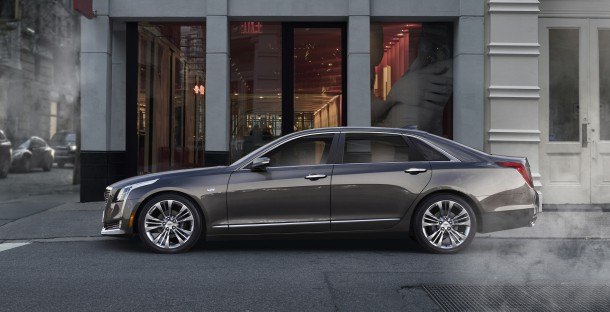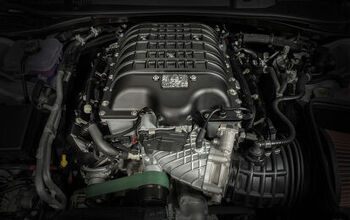Cadillac Touts Global June Sales "Surge" Amidst 2016 Global Sales Decline
Cadillac detailed the sources of its so-called global sales surge in June 2016 in a press release yesterday. In so doing, Cadillac called attention to its first-half global sales decline and the global rarity of the wreathless crest.
Cadillac has reason to pursue ( and then tout the results of its) increased global strength (or diminished global weakness). In the United States, Cadillac isn’t doing enough. The three top-selling Cadillac rivals — BMW, Mercedes-Benz, and Lexus — generate more U.S. sales than Cadillac does around the world. Globally. Everywhere.
Roughly 13,000 monthly sales in Cadillac’s historic North American market is a figure simply insufficient to secure a bright future for General Motors’ premium brand. Thus, Cadillac now intends to be a global luxury brand, and is in fact making inroads leading toward that goal.
China, for instance, now accounts for 35 percent of Cadillac’s global volume, up from 30 percent at this stage of 2015. In the European Union and Russia, home turf for top-tier luxury brands, Cadillac says a 41-percent year-over-year increase in the first-half of 2016 resulted in only 991 sales.
Perspective? In the United Kingdom in June alone, Mercedes-Benz sold 4,112 copies of the C-Class. Just the C-Class.
Moreover, even in China, where Cadillac’s global effort shows signs of increasing strength, Audi sold 5,190 more new vehicles in June than Cadillac sold in the first-half of 2016.
Cadillac’s lack of presence in the global marketplace isn’t surprising. GM’s efforts to expand the brand’s reach have at varying times been intermittent and half-hearted. The renewed focus we see now will not return instantaneous results.
Thus, Cadillac’s goals are modest. Said Cadillac president Johan de Nysschen in the Cadillac blast yesterday: “We can truly earn incremental volume growth as we build brand prestige.” As we build brand prestige. As opposed to being prestigious.
In its home market, however, Cadillac is neither a new entrant nor a foreign upstart. Yet Cadillac’s recent U.S. sales performance isn’t entirely out of sync with Cadillac’s dearth of global success. Just as the ATS, CTS, and futureless ELR are in decline around the world, they’re failing in the United States. U.S. ATS volume is down 22 percent to 9,764 units in 2016. CTS sales are down 18 percent to 7,906. The ELR is down 16 percent to 496. Combined sales of the XTS and its indirect CT6 successor are up by just 1.5 percent to 11,766. Admittedly, it’s early days for the CT6, but with more than three months of U.S. sales in the bag, fewer than 2,000 have been sold.
Cars, therefore, remain a small part of Cadillac’s U.S. business, forming just 41 percent of the brand’s U.S. volume, compared with 62 percent in the rest of the world. The blissfully profitable Escalade is a larger part of the U.S. equation than it is in global markets: 83 percent of global Escalade volume is U.S.-derived, compared with 52 percent for Cadillac’s other models.
The strength of Cadillac’s utilities, of course, brings up the subject of the ongoing SRX-to-XT5 transition. Excluding this top-selling Cadillac entrant from the equation shows Cadillac’s other models saw global first-half sales growth – albeit by a scant 65 units. It’s the XT5’s late first-half ramp-up that prompted Cadillac’s June surge. Global SRX/XT5 June volume rose 15 percent to 9,637 units, equal to nearly four out of every ten Cadillacs sold around the world last month.
In the U.S., meanwhile, the SRX and XT5 combined for 26,282 first-half sales, enough to claim second spot among premium brand utility vehicle sales so far this year. In June, even without the SRX’s contribution, the XT5 ranked fifth among luxury utility vehicle sales, a clear sign that Cadillac is set to reclaim its status as the prime challenger to the Lexus RX’s throne.
Unfortunately for Cadillac, cars still matter — even as the passenger car market is shrinking and the impact of SUVs and crossovers is being felt outside of America. Cadillac is woefully ineffective in the passenger car market.
Cadillac’s cars earn ride and handling plaudits from the enthusiast press, but when given the chance, the overwhelming majority of buyers still choose a 3 Series, 5 Series, or 7 Series; a C-Class, E-Class, or S-Class; an A4, A6, or A8. Much though that may appear to be the case in the United States, it’s an outcome far more evident around the world.
[Images: Cadillac, Chart: © 2016 Timothy Cain/The Truth About Cars]
Timothy Cain is the founder of GoodCarBadCar.net, which obsesses over the free and frequent publication of U.S. and Canadian auto sales figures. Follow on Twitter @goodcarbadcar and on Facebook.
More by Timothy Cain
Latest Car Reviews
Read moreLatest Product Reviews
Read moreRecent Comments
- ChristianWimmer I have a 2018 Mercedes A250 with almost 80,000 km on the clock and a vintage ‘89 Mercedes 500SL R129 with almost 300,000 km.The A250 has had zero issues but the yearly servicing costs are typically expensive from this brand - as expected. Basic yearly service costs around 400 Euros whereas a more comprehensive servicing with new brake pads, spark plugs plus TÜV etc. is in the 1000+ Euro region.The 500SL servicing costs were expensive when it was serviced at a Benz dealer, but they won’t touch this classic anymore. I have it serviced by a mechanic from another Benz dealership who also owns an R129 300SL-24 and he’ll do basic maintenance on it for a mere 150 Euros. I only drive the 500SL about 2000 km a year so running costs are low although the fuel costs are insane here. The 500SL has had two previous owners with full service history. It’s been a reliable car according to the records. The roof folding mechanism needs so adjusting and oiling from time to time but that’s normal.
- Theflyersfan I wonder how many people recalled these after watching EuroCrash. There's someone one street over that has a similar yellow one of these, and you can tell he loves that car. It was just a tough sell - too expensive, way too heavy, zero passenger space, limited cargo bed, but for a chunk of the population, looked awesome. This was always meant to be a one and done car. Hopefully some are still running 20 years from now so we have a "remember when?" moment with them.
- Lorenzo A friend bought one of these new. Six months later he traded it in for a Chrysler PT Cruiser. He already had a 1998 Corvette, so I thought he just wanted more passenger space. It turned out someone broke into the SSR and stole $1500 of tools, without even breaking the lock. He figured nobody breaks into a PT Cruiser, but he had a custom trunk lock installed.
- Jeff Not bad just oil changes and tire rotations. Most of the recalls on my Maverick have been fixed with programming. Did have to buy 1 new tire for my Maverick got a nail in the sidewall.
- Carson D Some of my friends used to drive Tacomas. They bought them new about fifteen years ago, and they kept them for at least a decade. While it is true that they replaced their Tacomas with full-sized pickups that cost a fair amount of money, I don't think they'd have been Tacoma buyers in 2008 if a well-equipped 4x4 Tacoma cost the equivalent of $65K today. Call it a theory.





































Comments
Join the conversation
I really like the new Caddy's and especially in V-form, they look great and perform even better. Having sold Infiniti's and Volvo's, it's so hard to get people out of their Bmw, Audi, Benz leases into something else, aside from Lexus. - You need a ridiculously good product - Amazing incentives, free maintenance and stellar service - The German trio dump their entry level models at cost, huge loaner programs. Hard to compete with that - CPO programs establish a great used-car buy, and implement an image of reliability in the product, true or not. Take years to build this, and one good product after the next. The Germans have been pumping out hit after hit.
In Los Angeles, pretty much every car brand is commonly visible. People in this state buy lots of F150s and Silverados, and lots of Priuses, with everything in between found everyday. In the mix, contemporary Cadillacs are common, and I don't mean just Escalade. We buy many ATS, CTS, V cars, SRX and in past years the older STS and XLR, so I don't know what's wrong with the rest of the country. While the Art & Science styling may be controversial, it appeals to buyers in part for that reason along with today's Cadillacs having distinctive, beautiful visual appeal. But Art & Science, along with dramatically-rising Cadillac vehicle engineering, quality and interiors, is only 12 years into a recovery and reversal of nearly 50 years of neglect and decline. GM is showing patience. You should too. My wife and I have been buying and driving Cadillacs for the past 10-1/2 years. 1st and 2nd gen CTS-V, SRX Turbo 3.0, XLR-V, now ATS Premium and ELR. Problems? None. In the context of their times, interiors have been satisfying, luxurious and durable. Vehicle finesse has steadily risen from roughly competitive to leading. Vehicle structures have been stiff and they stay tight. For all the yammering about the ATS' small back seat, I'm 6'3" and I can sit behind my 5'4" wife. I can't "sit behind myself," but I can't do that in *any* vehicle in the class. While I agree that in the current, short-sighted, CUV/SUV-preferring market Cadillac needs more than the excellent XT5, the root problem isn't the vehicles themselves today. The immediate bottleneck is marketing. Cadillac doesn't get enough buyers in any of its segments to drive its cars. Every Cadillac I've owned has won a steady stream of complements from casual bystanders and surprised (positive) reactions from people who rode in them or drove them, because they hadn't updated their perceptions of a previously-decayed brand. In the Awareness-Consideration-Trial-Purchase waterfall, Cadillac is anemic on converting Awareness to consideration -- so much so that one couldn't evaluate how they are doing on concerting trials into purchases. In L.A., the Cadillac service departments are excellent. The showrooms are either new or classic buildings that have been renovated. Sales staffs are less uniformly competitive with other luxury makes than they should be, but dealers' judgment in hiring is much better than it was. So GM has a continuing marketing and brand turn-around challenge, which I am not convinced the current Cadillac management is equipped to meet and put behind them. But the product is great. We'd all be better off if Americans relaxed their irrational (and arguably immature) concern for what's "on-brand" for them in luxury cars and just try a current Caddy. Phil